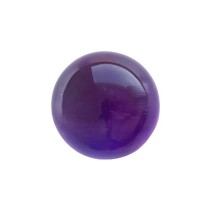Hvad er naturlig akvamarin?
Akvamarin er et dyrebart mineral værdsat for både dets skønhed og dets distinkte kemiske og fysiske egenskaber. Det er en del af berylgruppen, der er en sort af blågrøn beryl, med den kemiske formel Be3Al2(Si6O18).
Fysiske og kemiske egenskaber
- Farve: Nuancer af akvamarin spænder fra lyseblå til blågrøn og endda blågrøn. Dens karakteristiske farve skyldes tilstedeværelsen af spor af jern i krystalstrukturen. Afhængig af koncentrationen og valensen af jernionerne (Fe2+ og Fe3+), kan nuancen variere.
- Hårdhed: Akvamarin har en hårdhed på 7,5 til 8 på Mohs-skalaen, hvilket gør den holdbar nok til at blive brugt i smykker. Dens hårdhed skyldes dens kompakte og stabile krystallinske struktur.
- Luster: Akvamarin har en glasagtig glans, og dens klarhed kan variere fra gennemskinnelig til gennemsigtig. De mest værdifulde akvamariner er gennemsigtige, uden synlige indeslutninger.
- Spaltningsevne og fraktur: Akvamarin har en ufuldkommen spaltning og udviser en konchoidal til uregelmæssig fraktur. Disse egenskaber påvirker, hvordan det skæres og forarbejdes til brug i smykker.
- Krystallisering: Akvamarin krystalliserer i det sekskantede system og danner lange prismatiske krystaller med tydelige facetter. Disse krystaller kan nå imponerende størrelser, nogle gange veje flere kilogram.
Dannelse og geologiske aflejringer
Akvamarin dannes i granitiske pegmatitter og hydrotermiske årer, hvor berylliumrige opløsninger afkøles og krystalliserer. De nødvendige betingelser for dannelsen af akvamarin omfatter høje temperaturer og tryk samt tilstedeværelsen af specifikke kemiske elementer.
De mest berømte forekomster af akvamarin findes i Brasilien, især i staterne Minas Gerais og Bahia. Andre vigtige kilder omfatter Madagaskar, Nigeria, Pakistan, Rusland og USA (Colorado og Idaho). Disse aflejringer udforskes for akvamarinkrystaller af høj kvalitet.
Optiske egenskaber og spektroskopi
Akvamarin udviser et optisk fænomen kaldet pleokroisme, hvor krystallen kan vise to forskellige farver, når den ses fra forskellige vinkler. Normalt er pleokroiske farver blå og blågrønne.
Gennem spektroskopi viser akvamarin specifikke absorptionsbånd i det synlige spektrum på grund af de jernioner, der er til stede i dets struktur. Disse absorptionsbånd er nyttige til at identificere og differentiere akvamarin fra andre blå ædelstene.
Anvendelser og forarbejdning
-Smykker: På grund af sin attraktive farve og holdbarhed er akvamarin meget brugt i smykker, herunder ringe, halskæder, armbånd og øreringe. De mest værdifulde sten er dem med en intens blå farve, gennemsigtige og uden synlige indeslutninger.
- Forarbejdning: Akvamarin skæres i forskellige former og facetter for at maksimere glans og fremhæve farve. De mest almindelige snit inkluderer smaragdsnit, ovale snit og runde snit.
Historisk og kulturel betydning
Akvamarin har en lang historie og har været værdsat siden oldtiden. Romerne troede, at akvamarin beskyttede søfolk på havet og bragte held og lykke på rejser. I græsk mytologi blev akvamarin betragtet som guden Poseidons hellige sten. I moderne tradition er akvamarin fødselsstenen for marts måned og er forbundet med 19-års bryllupsdag.
Pleje og vedligeholdelse
For at bevare glansen af akvamarin anbefales det at rengøre den regelmæssigt med varmt vand og mild sæbe med en blød børste. Undgå udsættelse for skrappe kemikalier eller pludselige temperaturændringer. Det er også godt at opbevare akvamarin adskilt fra andre ædelstene for at undgå ridser.












